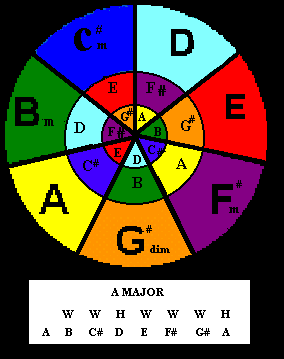Key of A major
Each Major key has an illustration that shows the chords and notes of that particular key.
The first Major key covered is the Key of A Major.
 |
|
| Each Major Key is always made up of the chords: |
Major, minor, minor, Major, Major, minor, diminished and Major chords. The W's and H's mean whole and half steps. Remember a whole step is two frets and a half step is one fret. If you study the chapter of C major and modes you will begin to see how all the modes are the same, but located at different positions. Each one of these illustrations will show all the chords that make up that particular key. So the illustration above shows the key of A Major. You can use all the chords listed above to play a lead or write a song in A Major.
|
Here is the Biggest Secret of all time when it comes to playing lead guitar. |
Every Major Key has a Relative or Natural minor.
Why is this important? If you know what key your playing in, you can play the pentatonic minor scale over that particular Major key. For example, if you were playing in the Key of A Major illustrated above, you could play F#m pentatonic. F#m is the natural minor to A Major. You should have the pentatonic scale memorized if you studied the chapter on the Am pentatonic. You would use the same fingering for the Am pentatonic scale root note fret, but start at the 2nd fret. The note at the second fret is the F# note. You could also play the Am pentatonic over the A chord or A major pentatonic. It all depends on the type of sound your looking for.
How do you determine the natural minor to the particular Major key? Look at the illustration above and find the yellow A in the outer ring. From that A note count back two. That would be the F#m and natural minor to A Major. The relative minor would be the sixth note in any major key.
|
Practice the key of A major scale. | |
|
Practice the A major pentatonic scale. |
Good Luck,
From the Jam Room






